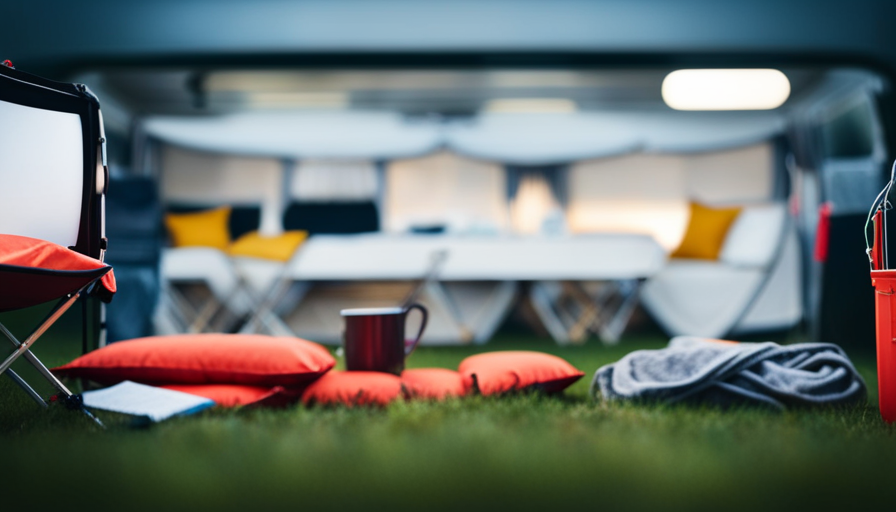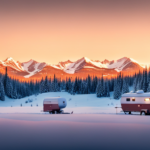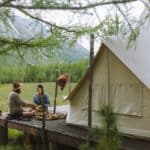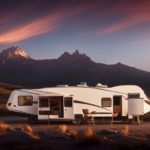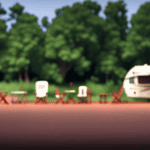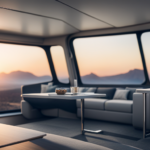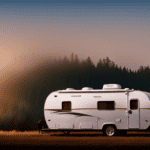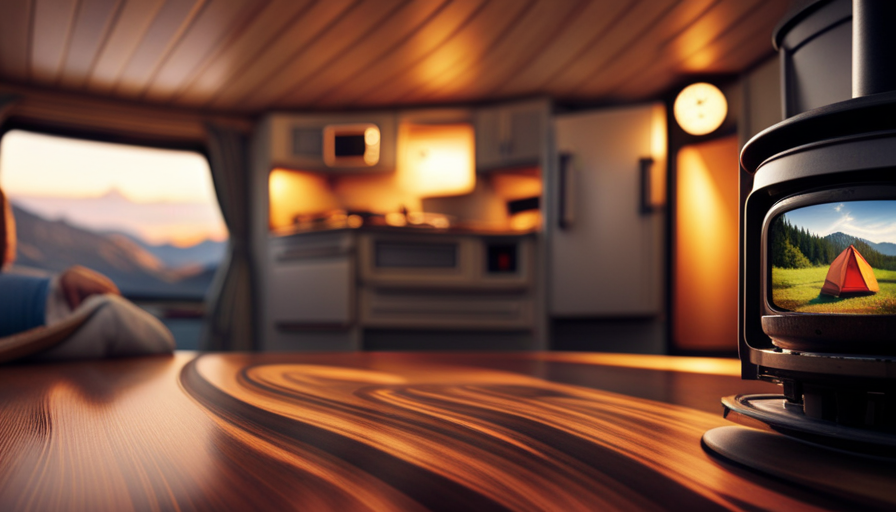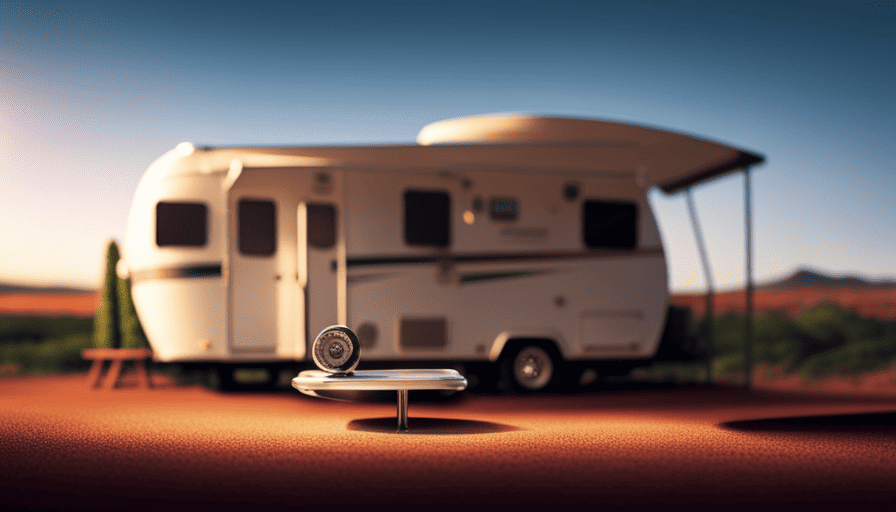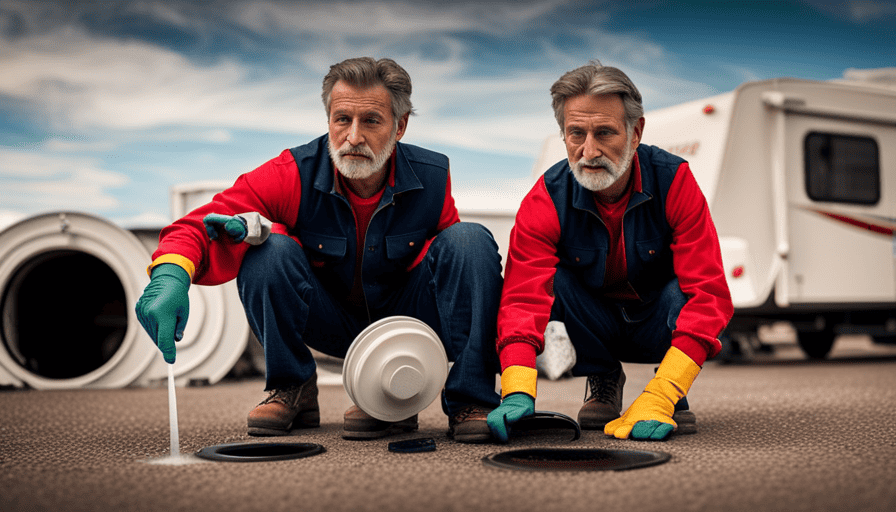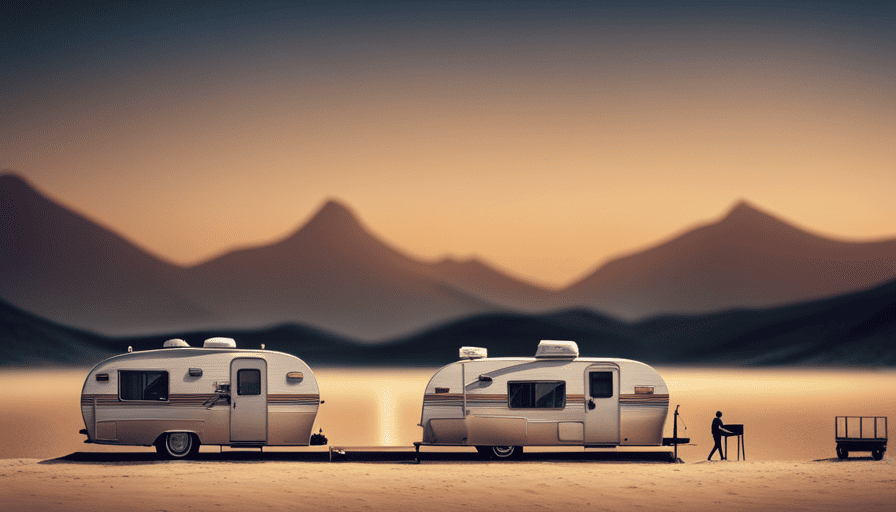By a stroke of serendipity, right when we were gearing up for our inaugural journey with our camper trailer, we were inundated with questions from other adventurers inquiring about packing necessities. It appeared that a significant number of individuals were keen on setting out and reveling in the liberation and adaptability afforded by traveling with a camper trailer, yet they were uncertain about what must-haves to bring along.
Well, worry no more, because we have you covered!
In this article, we will share our expert knowledge and experience on what to pack in your camper trailer. From cooking utensils and equipment to bedding and pillows, camping chairs and table to lighting and lanterns, we have thought of everything to ensure your journey is comfortable and enjoyable.
We will also delve into the importance of outdoor gear, such as hiking boots and rain jackets, as well as the essential camping stove and fuel you’ll need for cooking up delicious meals on the go. Of course, no adventure is complete without a well-stocked supply of food and drinks, as well as entertainment options to keep everyone entertained during downtime. And let’s not forget about the tools and equipment you’ll need for maintenance and repairs along the way.
So, let’s dive in and discover the must-haves for your next camper trailer trip!
Key Takeaways
- Cooking utensils and equipment: pots, pans, cutting board, knife set, spatulas, tongs, can opener, corkscrew, portable grill or stove
- Comfortable bedding: high-quality camping mattress, lightweight and moisture-wicking bedding, memory foam pillows, inflatable pillows, mattress topper
- Outdoor adventure gear: hiking boots, rain jackets
- First aid kit and emergency supplies: band-aids, adhesive tape, antiseptic wipes, ointment, gauze pads, elastic bandages, tweezers, scissors, flashlights, extra batteries, emergency blankets, whistle, signal mirror
Cooking utensils and equipment
Now let’s talk about what you’ll need to whip up some delicious meals on your camper trailer adventure! Cooking utensils are essential for any camper trailer trip. You’ll want to make sure you have the basics covered, such as pots and pans, a cutting board, a knife set, and cooking utensils like spatulas and tongs. These items will allow you to prepare a variety of meals, from simple breakfasts to gourmet dinners.
Don’t forget to pack a can opener and a corkscrew for those cans and bottles that need opening!
In addition to the cooking utensils, you’ll also need some cooking equipment. A portable grill or stove is a must-have for outdoor cooking. This will allow you to cook your meals easily and efficiently. Don’t forget to bring along a cooler or a mini-fridge to keep your perishable items fresh.
Having the right cooking utensils and equipment for your camper trailer adventure will ensure that you can enjoy delicious meals wherever you go. So, make sure to pack them all before hitting the road.
And as we move on to the next section about bedding and pillows, you’ll want to ensure a comfortable night’s sleep after enjoying your tasty meals.
Bedding and pillows
When it comes to bedding and pillows, you’ll be amazed to learn that a comfortable sleep can increase productivity by 34%. In a camper trailer, where space is limited, it’s important to choose bedding options wisely.
Here are four essential items to consider:
-
Mattress: Invest in a high-quality mattress that offers both comfort and support. Look for one that is specifically designed for camping, as it’ll be more durable and able to withstand the rigors of outdoor living.
-
Bedding: Opt for lightweight and moisture-wicking bedding to ensure a comfortable night’s sleep. Microfiber sheets are a great choice, as they’re soft, breathable, and easy to clean. Additionally, consider using a sleeping bag or a lightweight duvet instead of bulky blankets.
-
Pillows: Choose pillows that suit your personal preferences. Memory foam pillows provide excellent support and conform to your head and neck, while inflatable pillows are compact and easy to pack. Consider bringing a few different options to cater to individual needs.
-
Mattress topper: For added comfort, consider using a mattress topper. This’ll provide an extra layer of cushioning and insulation, ensuring a cozy and restful sleep.
Now that you have your bedding sorted, let’s move on to the next section about camping chairs and table.
Camping chairs and table
To enhance your camping experience, don’t forget to bring along a comfortable camping chair and a sturdy table for meals and relaxation. Camping chairs offer numerous benefits that’ll make your outdoor adventure more enjoyable. They provide a comfortable place to sit and relax after a long day of hiking or exploring. Whether you’re gathered around the campfire or simply taking in the beautiful scenery, having a comfortable chair to sit in can make all the difference.
When it comes to choosing a camping chair, look for one that’s lightweight and easy to fold and unfold. This’ll make it convenient to transport and set up at your campsite. Additionally, consider chairs that have built-in cup holders or storage pockets for added convenience.
A portable camping table is also an essential item to pack in your camper trailer. It provides a sturdy surface for preparing meals, playing games, or simply enjoying a picnic in nature. Look for a table that’s compact and easy to assemble, as you’ll want something that doesn’t take up too much space in your camper.
Now that you have a comfortable seating area and a convenient table for your meals, it’s time to think about lighting and lanterns.
Lighting and lanterns
With a flick of a switch, the camping experience is illuminated by the warm glow of lanterns and lighting. When it comes to lighting up the campsite, there are a few key items you should consider packing in your camper trailer.
Here are four essential lighting options for your camping adventure:
-
Camping lanterns: These portable, battery-powered lanterns provide a bright and reliable source of light. Look for lanterns that are compact, waterproof, and have adjustable brightness settings.
-
Solar powered lights: Harness the power of the sun with solar lights. These eco-friendly lights charge during the day and automatically turn on at night. They are perfect for lighting up walkways, tents, and outdoor areas.
-
Headlamps: A hands-free lighting solution, headlamps are essential for nighttime activities like cooking, setting up camp, or going for a late-night hike. Choose headlamps with adjustable straps and different light modes for versatility.
-
String lights: Create a cozy and inviting atmosphere with string lights. These decorative lights can be hung around your campsite, adding a touch of ambiance to your outdoor space.
Now that you have your lighting covered, let’s move on to the next section about outdoor gear (hiking boots, rain jackets, etc.).
Outdoor gear (hiking boots, rain jackets, etc.)
Now, as you delve into the realm of outdoor gear, it becomes imperative to equip yourself with essential items such as hiking boots and rain jackets for an unparalleled camping experience. When it comes to exploring hiking trails and embracing the great outdoors, having the right gear can make all the difference.
Hiking boots provide the necessary support and traction to tackle rugged terrains with ease, ensuring you stay comfortable and protected throughout your journey. Look for boots that’re waterproof and have a sturdy sole for added durability.
In addition to hiking boots, rain jackets are a must-have camping accessory. Weather conditions can change unexpectedly, and a good rain jacket’ll keep you dry and warm during those sudden downpours. Look for jackets that’re breathable, lightweight, and waterproof. It’s also a good idea to invest in other outdoor gear such as moisture-wicking socks, quick-drying pants, and moisture-wicking shirts to stay comfortable on the trails.
Now that you’re well-equipped with hiking boots and rain jackets, let’s move on to the next essential section: the first aid kit and emergency supplies. It’s important to be prepared for any unforeseen circumstances that may arise during your camping trip, so stay tuned for our next set of recommendations.
First aid kit and emergency supplies
Having a first aid kit and emergency supplies is crucial for any camping trip, as it ensures you’re prepared for any unexpected situations that may arise. Here’s a list of first aid kit essentials and an emergency preparedness checklist to help you pack for your camper trailer adventure:
- Band-aids and adhesive tape: These are essential for treating minor cuts, blisters, and abrasions.nn2. Antiseptic wipes and ointment: Use these to clean and disinfect wounds to prevent infection.nn3. Gauze pads and elastic bandages: These are useful for larger wounds and sprains, providing support and protection.nn4. Tweezers and scissors: These tools come in handy for removing splinters, cutting tape, or trimming bandages.
When packing your emergency supplies, consider including the following items:
- Flashlights and extra batteries: These’ll provide light during emergencies or power outages.nn2. Emergency blankets: These lightweight, space-saving blankets provide warmth and insulation.nn3. Whistle and signal mirror: These can help you attract attention and communicate in emergency situations.nn4. Non-perishable food and water: Always have a supply of food and water in case you get stranded or can’t access supplies.
With your first aid kit and emergency supplies packed, you can now focus on another essential item for your camping trip: the camping stove and fuel.
Camping stove and fuel
To ensure a successful camping trip, don’t forget to bring a reliable camping stove and enough fuel to cook delicious meals in the great outdoors. A camping stove is an essential piece of equipment that allows you to prepare hot meals even when you’re far away from civilization. It’s important to properly maintain your camping stove to ensure it functions optimally. Before your trip, check for any leaks, clean the burners, and make sure all the parts are in good working condition. This will help you avoid any unexpected issues while cooking.
When it comes to fuel options, there are a few to consider. Propane is a popular choice due to its convenience and efficiency. It’s readily available and easy to use. Another option is butane, which is also easily accessible and provides a consistent flame. If you prefer a more eco-friendly option, consider using a camping stove that runs on renewable fuels like wood or charcoal. These options may require a bit more effort to start and maintain, but they can add a unique flavor to your meals.
Now that you have your camping stove and fuel sorted, let’s move on to the next important aspect: food and drinks.
Food and drinks
When planning your camping trip, it’s important to bring a variety of food and drinks to satisfy everyone’s cravings.
Picnic essentials are a must-have for any camper trailer. Stock up on non-perishable snacks like granola bars, trail mix, and dried fruit for quick and easy munching on the go.
Don’t forget to pack a cooler with ice to keep perishable items like fruits, vegetables, and meats fresh.
Meal planning tips can also come in handy to ensure you have delicious and nutritious meals throughout your trip. Plan your meals ahead of time and pre-cook some dishes that can be easily reheated on the camping stove.
Don’t forget to pack essential cooking utensils like pots, pans, and a portable grill.
As for drinks, bring a variety of options such as water, soda, juice, and maybe even some adult beverages if that’s your thing.
With the right food and drinks, your camping trip will be a culinary delight.
And when it’s time to wind down after a satisfying meal, we’ll dive into the next section about entertainment (books, games, etc.).
Entertainment (books, games, etc.)
Bring along some books, games, and other forms of entertainment to make your camping trip an unforgettable and joy-filled experience. While technology has its place, there’s something special about disconnecting from screens and immersing ourselves in a good book.
Whether it’s a mystery novel or a classic piece of literature, books can transport us to different worlds and provide a much-needed escape. However, if you prefer the convenience of an e-reader, don’t forget to pack it along with a portable charger.
In addition to books, games can be a great way to bond with family and friends around the campfire. Classics like card games or board games are always a hit, but don’t be afraid to try something new. There are plenty of compact and travel-friendly games available that are perfect for camping. From strategy games to word puzzles, there’s something for everyone.
If you’re more inclined towards outdoor activities, consider bringing along some sports equipment. A frisbee, a football, or a volleyball can provide hours of fun at the campground or on the beach. These activities not only keep you active but also promote social interaction and friendly competition.
As we transition into discussing tools and equipment for maintenance and repairs, it’s important to remember that a well-prepared camper is a happy camper.
Tools and equipment for maintenance and repairs
When it comes to packing for a camper trailer adventure, entertainment is important, but so is being prepared for any maintenance or repair needs that may arise along the way. After all, you never know when you might need to fix a leaky faucet or replace a blown fuse. That’s why it’s essential to pack the right tools and equipment for maintenance and repairs.
First and foremost, organization is key when it comes to tools. A well-organized toolbox or storage system will save you time and frustration when you’re trying to find the right tool for the job. Consider using a pegboard or labeled containers to keep everything in its place.
In terms of specific tools and equipment, here are three essential items to pack:
-
Basic toolset: A set of screwdrivers, wrenches, pliers, and a hammer will cover most of your repair needs.
-
Multi-meter: This handy device will help you diagnose electrical issues and troubleshoot any problems with your camper’s electrical system.
-
Duct tape and zip ties: These versatile items can temporarily fix a variety of issues until you can properly address them.
Remember, prevention is key when it comes to maintenance. Regularly inspect your camper trailer for any signs of wear and tear and address any issues promptly. By packing the right tools and staying organized, you’ll be ready to handle any maintenance or repair needs that come your way during your camper trailer adventure.
Frequently Asked Questions
Is it necessary to bring a portable toilet for a camper trailer?
Oh, the eternal debate of whether or not to bring a portable toilet for our beloved camper trailer.
Let’s dive into the abyss of portable toilet alternatives, shall we?
While some may argue that nature’s call can be answered in the great outdoors, others prefer the convenience and sanitary bliss of a portable toilet.
This decision may be influenced by factors such as camping with pets, where finding a suitable spot for them to do their business can be quite the adventure.
What type of camping stove is best for a camper trailer?
Based on my experience, the best type of camping stove for a camper trailer is a portable grill. Portable grills are convenient, easy to use, and provide a great cooking experience while on the road. They come in various sizes and fuel options, such as propane, charcoal, or even wood pellets. Propane is a popular choice due to its convenience and availability. However, if you prefer the smoky flavor, charcoal or wood pellet grills are worth considering.
How much food and drinks should I pack for a week-long camping trip?
When it comes to food planning for a week-long camping trip, it’s important to strike a balance between having enough to eat and not overpacking.
Start by considering the number of meals you’ll need and the type of meal preparation you’ll be doing. Plan for a mix of easy-to-make meals and some that require more effort.
Don’t forget to pack snacks and drinks to keep everyone fueled and hydrated throughout the trip.
Are there any specific safety precautions to consider when using lanterns in a camper trailer?
When using lanterns in a camper trailer, it’s important to follow safety precautions. Always ensure that the lantern is stable and secure before turning it on. Keep flammable materials away from the lantern and never leave it unattended. It’s also a good idea to have alternative lighting options, such as battery-powered LED lights or flashlights, in case of emergencies. These alternatives provide adequate lighting while minimizing the risks associated with open flames.
What type of entertainment options are recommended for a camper trailer?
Outdoor enthusiasts often ponder over the perfect entertainment options for their camper trailers. When it comes to amusement, nothing beats the blissful combination of outdoor games and streaming options.
Engaging in lively outdoor games like cornhole or frisbee can add a burst of excitement to your camping experience. And for those cozy nights, streaming options like portable projectors or Wi-Fi-enabled devices allow you to enjoy your favorite movies or shows under the starry sky.
So, pack your sense of adventure and entertainment, and let the fun begin!
What Can I Put in My Camper Toilet to Control Odors?
Looking for camper toilet smell solutions? There are several options to control odors in your camper toilet. You can use specialized chemicals or additives specifically designed for RV toilets. Another option is using biodegradable toilet paper to prevent clogging and reduce unpleasant smells. Additionally, proper ventilation and regular cleaning can also help mitigate camper toilet odors.
Conclusion
In conclusion, packing for a camper trailer adventure is an art form that requires careful consideration and preparation.
As experienced travelers, we know the importance of having the right equipment and supplies to ensure a comfortable and enjoyable trip.
From cooking utensils and bedding to outdoor gear and entertainment options, every item plays a crucial role in creating unforgettable memories.
So, as you embark on your own camper trailer journey, remember the suspense of what lies ahead and the excitement of discovering the unknown. Happy travels!

